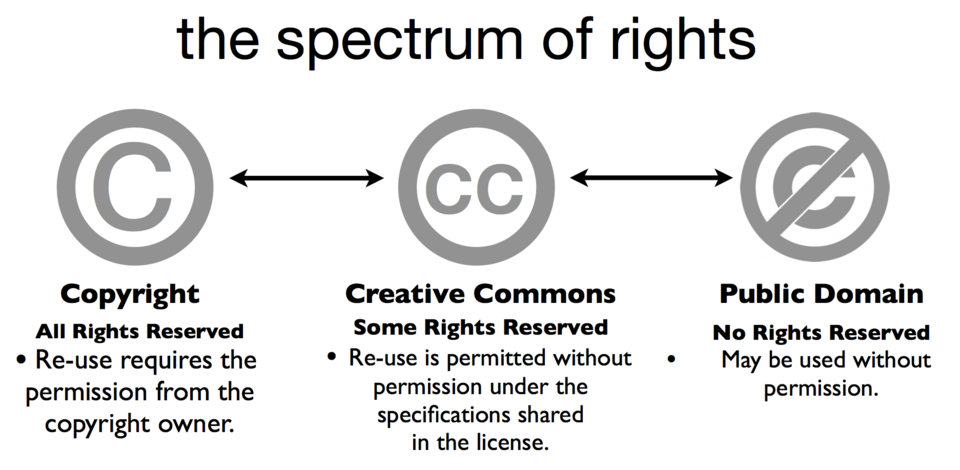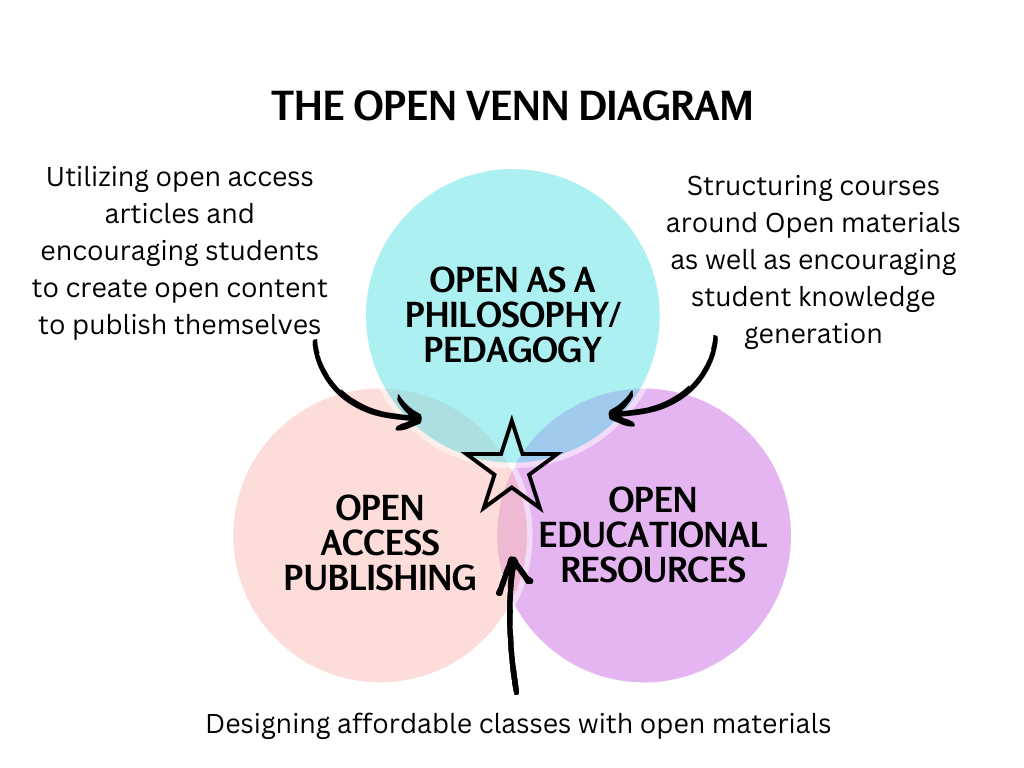1 Open Definitions
What is Open?
Open is a holistic term that describes a movement towards more affordable and accessible learning content, materials, and practice. Open consists of three focal areas of work:
- Open Pedagogy – the overall practice of embracing materials which incorporate the 5 R’s of remix, reuse, revise, remix, and redistribute. Instructors may create their own materials and openly license them, or adapt existing materials. Typically, open pedagogy seeks to embrace the unique potential for student engagement and participation presented by using open resources, such as having students co-create resources to be used by future classes.
- Open Access in Publishing – the practice of publishing in Open Access journals, which distribute their article content freely and without charge to readers. Some open journals charge article processing fees wherein the publishing authors must pay sometimes expensive charges to have their articles published.
- Open Educational Resources (OER) – a catch all term for any resources used in an educational context that have open qualities such as a creative commons license. Open Textbooks are technically a kind of OER, but in practice OER typically refers to everything besides open textbooks. Think assignments, in class activities, and supplemental materials used in addition to the main text or reading list.
Open as a Pedagogy or Philosophy
Open pedagogy is “the practice of engaging with students as creators of information rather than simply consumers of it. It’s a form of experiential learning in which students demonstrate understanding through the act of creation. The products of open pedagogy are student created and openly licensed so that they may live outside of the classroom in a way that has an impact on the greater community.”[1] This could be seen as opportunities for students to create games, blogs, guides, or other materials in which they are teaching other students about concepts or topics.
This learner-driven education model serves as a high-impact practice that leaves a lot of power and flexibility not only in the hands of the students but in the hands of educators. It gives teachers the academic freedom to develop engaging classrooms that embrace collaboration, student agency, and authenticity. [2]
Open Access in Publishing
Open Access seeks to grant free and open online access to research and scholarly information. A publication can be defined as Open Access if “there are no financial, legal or technical barriers to accessing it – that is to say when anyone can read, download, copy, distribute, print, search for and search within the information, or use it in education or in any other way within the legal agreements.”[3]
This style of publishing opposes the traditional subscription-based model that costs libraries and their users thousands of dollars. But publishing in Open Access journals doesn’t just save money, it also increases visibility and awareness of your work.
But how does copyright work?
You can tell if materials are open by the type of copyright associated with them. Open licenses are what make Open Educational Resources (OER) possible. They enable creators to proactively communicate to the public about how copyrighted material can and cannot be used. Open licensing options fill the gap between “all rights reserved” copyright, which protects everything from storing copies of a work to modifying the work, and the public domain, in which there is no copyright protection.

The diagram “the spectrum of rights” from “Making Sense of the Spectrum of Rights” by Michelle Pacansky-Brock is licensed CC BY-NC-ND 4.0.
There are four basic requirements that in various combinations make up CC Licenses. They are indicated by the following icons:
 Attribution: You let others copy, distribute, display, and perform your copyrighted work—and derivative works based upon it—but only if they give you credit the way you request. This element is a part of all six licenses.
Attribution: You let others copy, distribute, display, and perform your copyrighted work—and derivative works based upon it—but only if they give you credit the way you request. This element is a part of all six licenses.
 Non-Commercial: You let others copy, distribute, display, and perform your work—and derivative works based upon it—but for noncommercial purposes only.
Non-Commercial: You let others copy, distribute, display, and perform your work—and derivative works based upon it—but for noncommercial purposes only.
 No Derivatives: You let others copy, distribute, display, and perform only exact copies of your work, not derivative works based upon it.
No Derivatives: You let others copy, distribute, display, and perform only exact copies of your work, not derivative works based upon it.
 Share Alike: You allow others to distribute derivative works only under a license identical to the license that governs your work.
Share Alike: You allow others to distribute derivative works only under a license identical to the license that governs your work.
These symbols combine to instruct you on how to use the material. The six licenses and the Creative Commons Public Domain designation are shown below in order of the amount of freedom they provide for users. The spectrum includes two licenses that are not OER because they do not allow for revision and remix (i.e., CC BY-ND and CC BY-NC-ND).
 The Creative Commons image from “Increasing College Affordability with Open Educational Resources” by Cable Green is licensed CC BY 4.0
The Creative Commons image from “Increasing College Affordability with Open Educational Resources” by Cable Green is licensed CC BY 4.0
If you are interested in learning more about Creative commons and perhaps getting a certificate, please visit: Creative Commons Certificate for Educators, Academic Librarians and GLAM
Open Educational Resources (OER)
Open Educational Resources (OER) are educational content that are either in the public domain or openly licensed. That means users are allowed to retain, reuse, revise, remix, and redistribute (5R activities) content within an OER.[4]
David Wiley, the Chief Academic Officer of Lumen Learning, explains the meaning of these 5R activities:
- Retain – the right to make, own, and control copies of the content (e.g., download, duplicate, store, and manage)
- Reuse – the right to use the content in a wide range of ways (e.g., in a class, in a study group, on a website, in a video)
- Revise – the right to adapt, adjust, modify, or alter the content itself (e.g., translate the content into another language)
- Remix – the right to combine the original or revised content with other material to create something new (e.g., incorporate the content into a mashup)
- Redistribute – the right to share copies of the original content, your revisions, or your remixes with others (e.g., give a copy of the content to a student or friend)[5]
Not only do OERs help students save money on textbooks and other educational expenses, but they also allow you to have more control over the content in your course. You can tailor materials to fit your specific needs and ensure that it stay up-to-date.
- Bonica, M. J., Judge, R., Bernard, C., & Murphy, S. (2018). Open Pedagogy Benefits to Competency Development: From Sage on the Stage to Guy in the Audience. The Journal of Health Administration Education, 35(1), 9–27. ↵
- Iowa State University. (n.d.). Open pedagogy: Open Scholarship Services: Iowa State University. Open Pedagogy | Open Scholarship Services . https://open.lib.iastate.edu/open-education/pedagogy#:~:text=Open%20pedagogy%20is%20%22the%20practice,through%20the%20act%20of%20creation. ↵
- openaccess.nl. (n.d.). What is open access? https://www.openaccess.nl/en/what-is-open-access ↵
- Some content on this page and throughout this guide comes from CUNY Pressbooks Guide by Andrew McKinney; Rachael Nevins; and Elizabeth Arestyl is licensed under a Creative Commons Attribution-NonCommercial 4.0 International License, except where otherwise noted. ↵
- These definitions are excerpted and adapted from Defining the “Open” in Open Content and Open Educational Resources by David Wiley, published under a Creative Commons Attribution 4.0 International License. ↵ ↵


